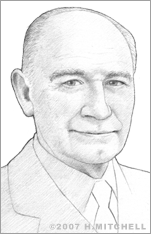William Upjohn
Before the turn of the 20th century, when faced with an illness that required medication, patients were accustomed to ingesting pharmaceuticals in liquid form or as pills with hard coatings. The problem was, however, that these coatings were so hard that sometimes the pills did not dissolve in the patient’s system; in these cases they passed right through, and the person being treated received no benefit at all. Dr. William Erastus Upjohn solved this issue with his 1884 invention of the friable pill, which means a pill that is easily crushable.
Upjohn was born in 1853 in Richland, Michigan, one of 12 children born to physician Uriah Upjohn. Four of the Upjohn children became doctors; William attended the University of Michigan where he completed his medical degree in 1875. He then set up his own practice in Hastings, Michigan.
He became determined to solve the non-dissolvable pill issue when he was in his 20s. He started working on new formulas for pills in his home in the early 1880s. By 1884 he had developed a pill that a person could crush between his fingers. This pill dissolved easily in the stomach. Upjohn received a patent for the pill in 1885.
Meanwhile, he also began working on a machine to mass-produce the pills. With his brother Henry he set up a company to manufacture them. The Upjohn Pill and Granule Company began operating in Kalamazoo, Michigan, in 1886. Upjohn was a natural when it came to marketing; he set up a demonstration kit including sample pills to doctors around the country. His kits allowed the doctors to compare his pills to typical hard pills, showing them how easily the new pills could be crushed into a pine board.
Upjohn’s pills gained popularity quickly. Two more of his brothers joined the company, and soon it was producing more pills and tablets; by 1902 it was offering a variety of pharmaceutical products and was well on its way to becoming a multi-billion-dollar business.
Upjohn eventually bought out his brothers; for nearly 40 years he served as president of the Upjohn Company. He also became very active in civic affairs within Kalamazoo, where he helped to incorporate the city in 1914 and where he was elected its first mayor. He also established the W. E. Upjohn Institute for Employment Research and donated the 17-acre Upjohn Park to the city. He retired from Upjohn in 1920 and devoted much of his time from then to gardening and philanthropy.
Upon his death in 1932, his nephew, Lawrence Upjohn, assumed management of the Upjohn Company. The operation remained a family business until 1968; meanwhile it expanded internationally and developed, manufactured and distributed a variety of important and highly popular drugs, including antibiotics such as penicillin. The firm became a giant in the pharmaceuticals industry, employing some 30,000 around the world. In 1995, it merged with Pharmacia. In 2002, Pharmacia Corp. was purchased by Pfizer.


